
Nucleosynthesis:
The Universe is now 1 minute old, and all the anti-matter has been destroyed by annihilation with matter. The leftover matter is in the form of electrons, protons and neutrons. As the temperature continues to drop, protons and neutrons can undergo fusion to form heavier atomic nuclei. This process is called nucleosynthesis.

Its harder and harder to make nuclei with higher masses. So the most common substance in the Universe is hydrogen (one proton), followed by helium, lithium, beryllium and boron (the first elements on the periodic table). Isotopes are formed, such as deuterium and tritium, but these elements are unstable and decay into free protons and neutrons.
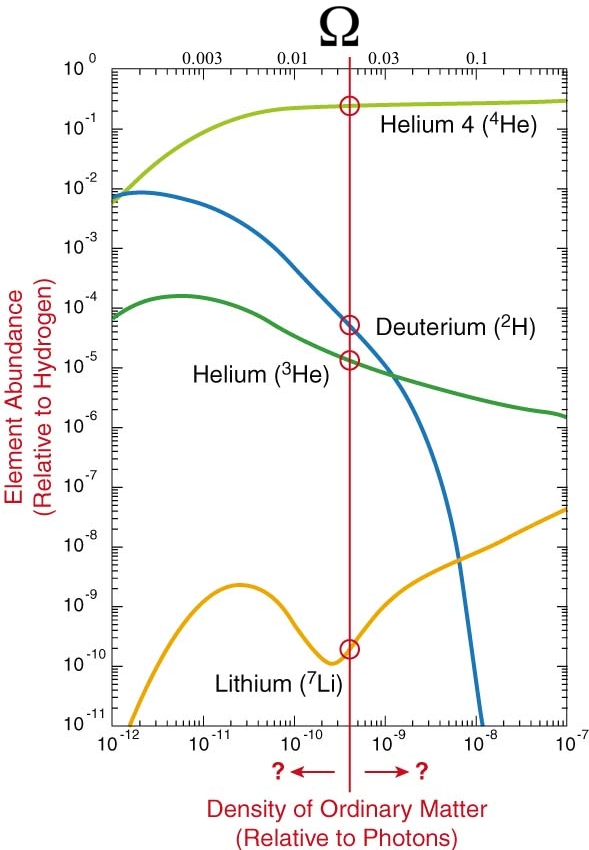
Note that this above diagram refers to the density parameter, ![]() , of
baryons, which is close to 0.03. However, much of the Universe is in the form
of dark matter, which brings the value of
, of
baryons, which is close to 0.03. However, much of the Universe is in the form
of dark matter, which brings the value of ![]() M to 0.3.
M to 0.3.
A key point is that the ratio of hydrogen to helium is extremely sensitive to the density of matter in the Universe (the parameter that determines if the Universe is open, flat or closed). The higher the density, the more helium produced during the nucleosynthesis era. The current measurements indicate that 75% of the mass of the Universe is in the form of hydrogen, 24% in the form of helium and the remaining 1% in the rest of the periodic table (note that your body is made mostly of these `trace' elements). Note that since helium is 4 times the mass of hydrogen, the number of hydrogen atoms is 90% and the number of helium atoms is 9% of the total number of atoms in the Universe.
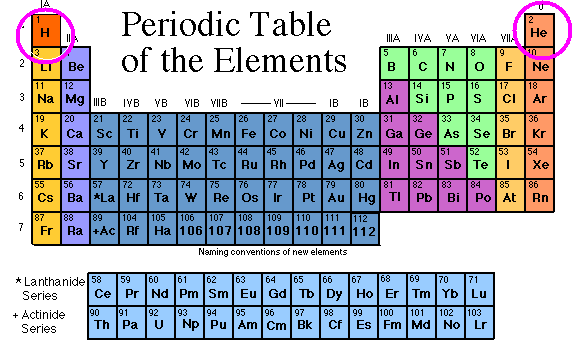
There are over 100 naturally occurring elements in the Universe and classification makes up the periodic table. The very lightest elements are made in the early Universe. The elements between boron and iron (atomic number 26) are made in the cores of stars by thermonuclear fusion, the power source for all stars.
The fusion process produces energy, which keeps the temperature of a stellar core high to keep the reaction rates high. The fusing of new elements is balanced by the destruction of nuclei by high energy gamma-rays. Gamma-rays in a stellar core are capable of disrupting nuclei, emitting free protons and neutrons. If the reaction rates are high, then a net flux of energy is produced.
Fusion of elements with atomic numbers (the number of protons) greater than 26 uses up more energy than is produced by the reaction. Thus, elements heavier than iron cannot be fuel sources in stars. And, likewise, elements heavier than iron are not produced in stars, so what is their origin?.
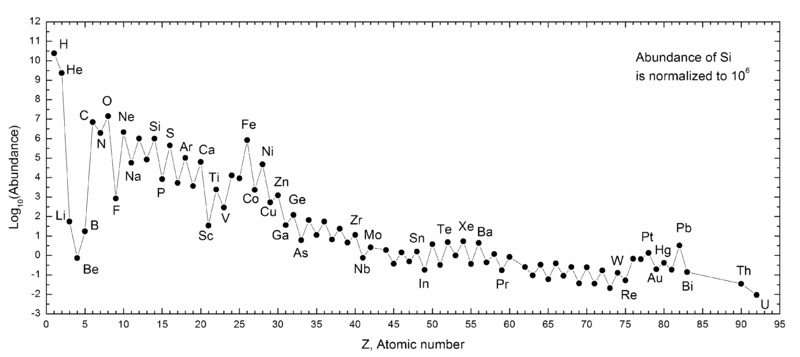
The construction of elements heavier than Fe (iron) involves nucleosynthesis by neutron capture. A nuclei can capture or fuse with a neutron because the neutron is electrically neutral and, therefore, not repulsed like the proton. In everyday life, free neutrons are rare because they have short half-life's before they radioactively decay. Each neutron capture produces an isotope, some are stable, some are unstable. Unstable isotopes will decay by emitting a positron and a neutrino to make a new element.
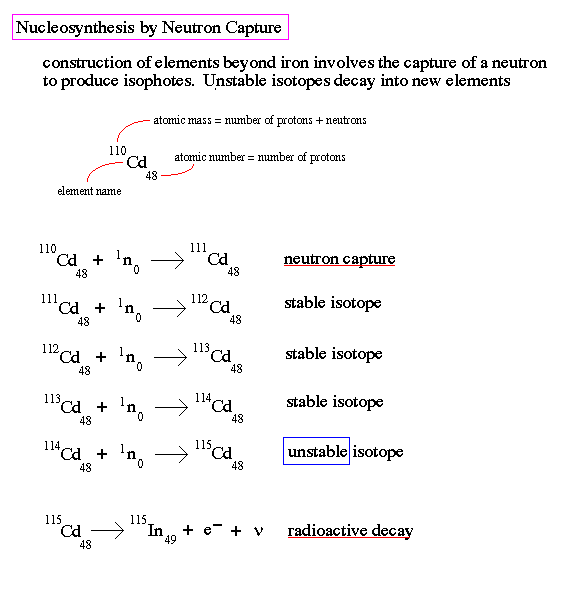
Neutron capture can happen by two methods, the s and r-processes, where s and r stand for slow and rapid. The s-process happens in the inert carbon core of a star, the slow capture of neutrons. The s-process works as long as the decay time for unstable isotopes is longer than the capture time. Up to the element bismuth (atomic number 83), the s-process works, but above this point the more massive nuclei that can be built from bismuth are unstable.
The second process, the r-process, is what is used to produce very heavy, neutron rich nuclei. Here the capture of neutrons happens in such a dense environment that the unstable isotopes do not have time to decay. The high density of neutrons needed is only found during a supernova explosion and, thus, all the heavy elements in the Universe (radium, uranium and plutonium) are produced this way. The supernova explosion also has the side benefit of propelling the new created elements into space to seed molecular clouds which will form new stars and solar systems.
Ionization:
The last stage in matter production is when the Universe cools sufficiently for electrons to combine with the proton/neutron nuclei and form atoms. Constant impacts by photons knock electrons off of atoms which is called ionization. Lower temperatures mean photons with less energy and fewer collisions. Thus, atoms become stable at about 15 minutes after the Big Bang.
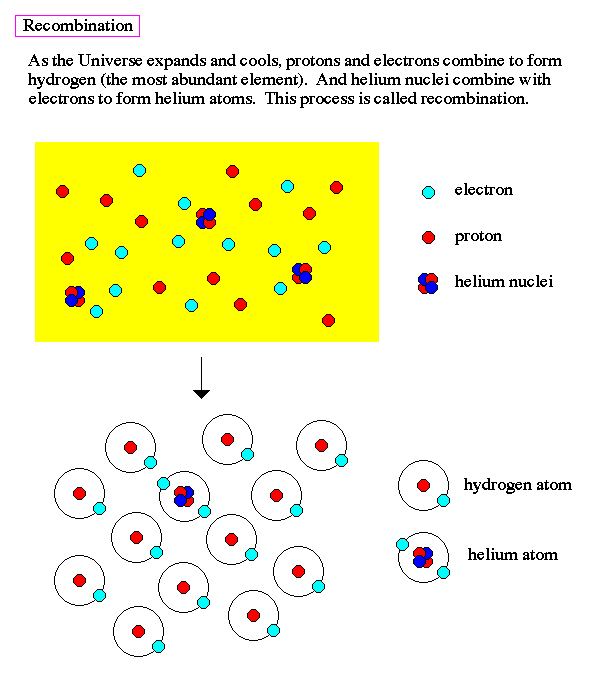
These atoms are now free to bond together to form simple compounds, molecules, etc. And these are the building blocks for galaxies and stars.
Radiation/Matter Dominance :
Even after the annihilation of anti-matter and the formation of protons, neutrons and electrons, the Universe is still a violent and extremely active environment. The photons created by the matter/anti-matter annihilation epoch exist in vast numbers and have energies at the x-ray level.
Radiation, in the form of photons, and matter, in the form of protons, neutrons and electron, can interact by the process of scattering. Photons bounce off of elementary particles, much like billiard balls. The energy of the photons is transfered to the matter particles. The distance a photon can travel before hitting a matter particle is called the mean free path.
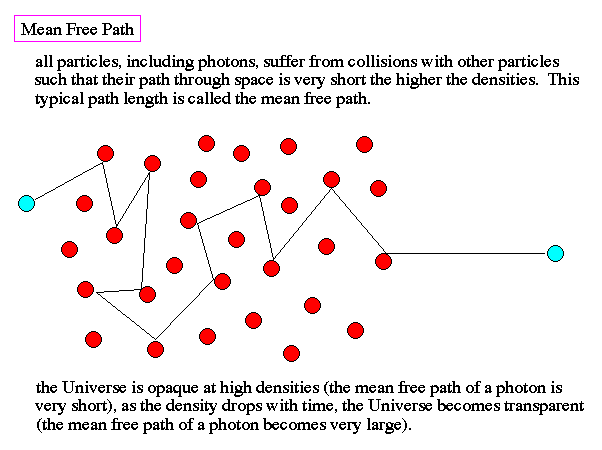
Since matter and photons were in constant contact, their temperatures were the same, a process called thermalization. Note also that the matter can not clump together by gravity. The impacts by photons keep the matter particles apart and smoothly distributed.
The density and the temperature for the Universe continues to drop as it expands. At some point about 15 minutes after the Big Bang, the temperature has dropped to the point where ionization no longer takes places. Neutral atoms can form, atomic nuclei surrounded by electron clouds. The number of free particles drops by a large fraction (all the protons, neutrons and electron form atoms). And suddenly the photons are free to travel without collisions, this is called decoupling.

The Universe becomes transparent at this point. Before this epoch, a photon couldn't travel more that a few inches before a collision. So an observers line-of-sight was only a few inches and the Universe was opaque, matter and radiation were coupled. This is the transition from the radiation era to the matter era.
Density Fluctuations:
The time of neutral atom construction is called recombination, this is also the first epoch we can observe in the Universe. Before recombination, the Universe was too dense and opaque. After recombination, photons are free to travel through all of space. Thus, the limit to our observable Universe is back in time (outward in space) to the moment of recombination.
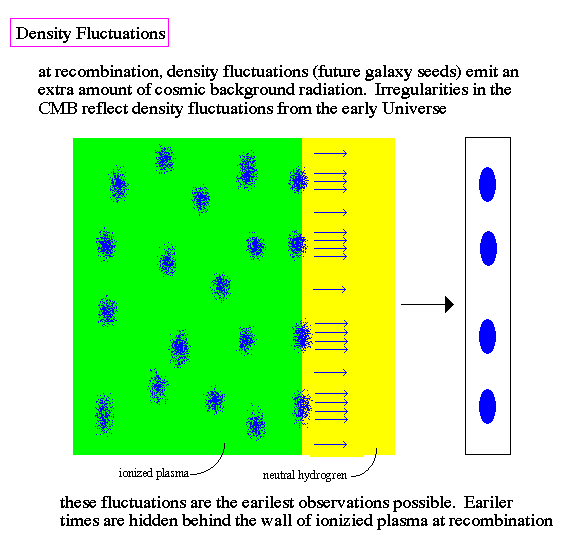
The time of recombination is also where the linked behavior between photons and matter decouples or breaks, and is also the last epoch where radiation traces the mass density. Photon/matter collisions become rare and the evolution of the Universe is dominated by the behavior of matter (i.e. gravity), so this time, and until today, is called the matter era.
Today, radiation in the form of photons have a very passive role in the evolution of the Universe. They only serve to illuminate matter in the far reaches of the Galaxy and other galaxies. Matter, on the other hand, is free to interact without being jousted by photons. Matter becomes the organizational element of the Universe, and its controlling force is gravity.
Notice that as the Universe ages it moves to more stable elements. High energy radiation (photons) are unstable in their interactions with matter. But, as matter condenses out of the cooling Universe, a more stable epoch is entered, one where the slow, gentle force of gravity dominates over the nuclear forces of earlier times.
Much of the hydrogen that was created at recombination was used up in the formation of galaxies, and converted into stars. There is very little reminant hydrogen between galaxies, the so-called intergalactic medium, except in clusters of galaxies. Clusters of galaxies frequently have a hot hydrogen gas surrounding the core, this is leftover gas from the formation of the cluster galaxies that has been heated by the motions of the cluster members.

|
|

|